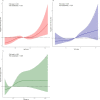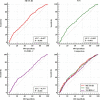Relationship between a novel non-insulin-based metabolic score for insulin resistance (METS-IR) and coronary artery calcification
- PMID: 36357872
- PMCID: PMC9647937
- DOI: 10.1186/s12902-022-01180-7
Relationship between a novel non-insulin-based metabolic score for insulin resistance (METS-IR) and coronary artery calcification
Abstract
Background and aims: A novel non-insulin-based metabolic score for insulin resistance (METS-IR) index has been proposed as a simple and reliable alternative insulin resistance (IR) marker, but its the predictive value in asymptomatic adults with coronary artery calcification (CAC) remains unclear.
Methods and results: We enrolled 1576 participants without cardiovascular disease (CVD), who underwent multidetector computed tomography. Logistic regression, restricted cubic spline models and receiver operating characteristic (ROC) curves were used to examine the association between METS-IR, the ratio of triglyceride to high-density lipoprotein cholesterol (TG/HDL-C) and triglyceride glucose index (TyG index) and CAC. In multivariate logistic regression analysis, the increase in METS-IR was independently associated with a higher prevalence of CAC (all P < 0.05 in Models 1-3). Furthermore, restricted cubic splines indicated that the significance of METS-IR in predicting CAC was higher than that of other IR indexes. In ROC curve analysis, without considering the P value, the area under the curve of CAC predicted by METS-IR was higher than that of other IR indexes (METS-IR, 0.607; TyG index, 0.603; TG/HDL-C, 0.577).
Conclusion: Compared with other IR indexes, METS-IR may have better discrimination ability in predicting the incidence of CAC in asymptomatic adults without CVD.
Keywords: Coronary artery calcification; Insulin resistance; Metabolic score for insulin resistance; Triglyceride glucose index.
© 2022. The Author(s).
Conflict of interest statement
The authors have no conflicts of interest to disclose.
Figures



Similar articles
-
The triglyceride glucose: high-density lipoprotein cholesterol ratio is associated with coronary artery calcification evaluated via non-gated chest CT.Cardiovasc Diabetol. 2024 Oct 24;23(1):376. doi: 10.1186/s12933-024-02464-z. Cardiovasc Diabetol. 2024. PMID: 39449019 Free PMC article.
-
Triglyceride-glucose index as a superior marker of insulin resistance for predicting long-term major adverse cardiovascular events following coronary artery bypass grafting in China.Sci Rep. 2025 Feb 22;15(1):6450. doi: 10.1038/s41598-025-87967-9. Sci Rep. 2025. PMID: 39987346 Free PMC article.
-
Comparison of three non-insulin-based insulin resistance indexes in predicting the presence and severity of coronary artery disease.Front Cardiovasc Med. 2022 Jul 29;9:918359. doi: 10.3389/fcvm.2022.918359. eCollection 2022. Front Cardiovasc Med. 2022. PMID: 35966520 Free PMC article.
-
Association between various insulin resistance indices and cardiovascular disease in middle-aged and elderly individuals: evidence from two prospectives nationwide cohort surveys.Front Endocrinol (Lausanne). 2024 Nov 22;15:1483468. doi: 10.3389/fendo.2024.1483468. eCollection 2024. Front Endocrinol (Lausanne). 2024. PMID: 39649228 Free PMC article.
-
The accuracy of triglyceride-glucose (TyG) index for the screening of metabolic syndrome in adults: A systematic review and meta-analysis.Nutr Metab Cardiovasc Dis. 2022 Dec;32(12):2677-2688. doi: 10.1016/j.numecd.2022.07.024. Epub 2022 Sep 2. Nutr Metab Cardiovasc Dis. 2022. PMID: 36336547
Cited by
-
Association between metabolic score for insulin resistance and clinical outcomes: insights from the Tehran lipid and glucose study.Nutr Metab (Lond). 2024 Jun 12;21(1):34. doi: 10.1186/s12986-024-00808-w. Nutr Metab (Lond). 2024. PMID: 38867289 Free PMC article.
-
Association of the metabolic score for insulin resistance with cardiovascular diseases, cardiovascular and all-cause mortality in Chinese hypertensive population.Front Endocrinol (Lausanne). 2024 Mar 8;14:1326436. doi: 10.3389/fendo.2023.1326436. eCollection 2023. Front Endocrinol (Lausanne). 2024. PMID: 38523869 Free PMC article.
-
Association of non-insulin-based insulin resistance indices with disease severity and adverse outcome in idiopathic pulmonary arterial hypertension: a multi-center cohort study.Cardiovasc Diabetol. 2024 May 3;23(1):154. doi: 10.1186/s12933-024-02236-9. Cardiovasc Diabetol. 2024. PMID: 38702735 Free PMC article.
-
Association between the homeostasis model assessment of insulin resistance and coronary artery calcification: a meta-analysis of observational studies.Front Endocrinol (Lausanne). 2023 Nov 27;14:1271857. doi: 10.3389/fendo.2023.1271857. eCollection 2023. Front Endocrinol (Lausanne). 2023. PMID: 38089605 Free PMC article.
-
Impact of the baseline insulin resistance surrogates and their longitudinal trajectories on cardiovascular disease (coronary heart disease and stroke): a prospective cohort study in rural China.Front Endocrinol (Lausanne). 2023 Dec 22;14:1259062. doi: 10.3389/fendo.2023.1259062. eCollection 2023. Front Endocrinol (Lausanne). 2023. PMID: 38189050 Free PMC article.
References
-
- Sangiorgi G, Rumberger JA, Severson A, Edwards WD, Gregoire J, Fitzpatrick LA, et al. Arterial Calcification and Not Lumen Stenosis Is Highly Correlated With Atherosclerotic Plaque Burden in Humans: A Histologic Study of 723 Coronary Artery Segments Using Nondecalcifying Methodology. J Am Coll Cardiol. 1998;31(1):126–33. doi: 10.1016/s0735-1097(97)00443-9. - DOI - PubMed
MeSH terms
Substances
LinkOut - more resources
Full Text Sources
Medical
Miscellaneous

